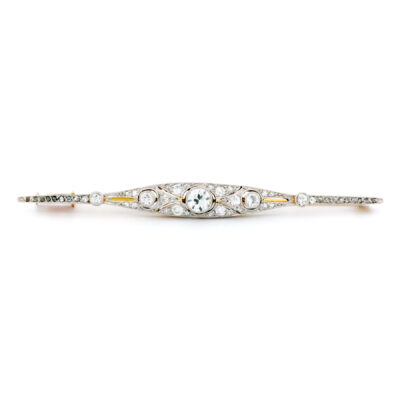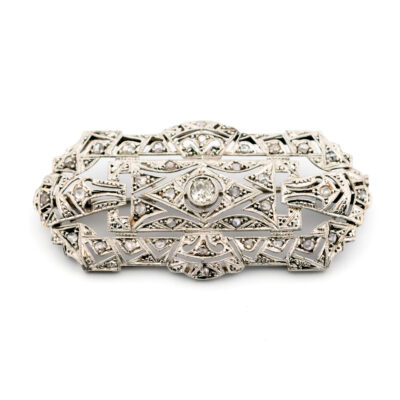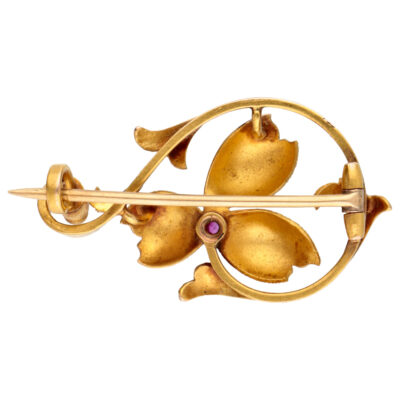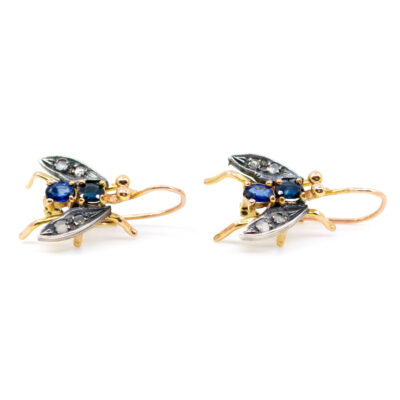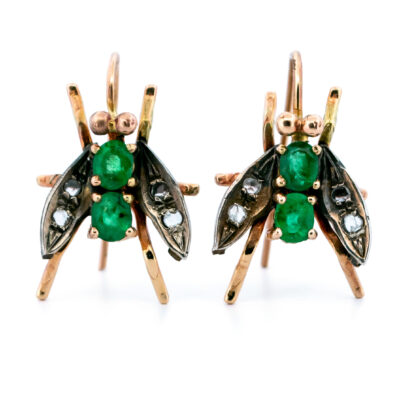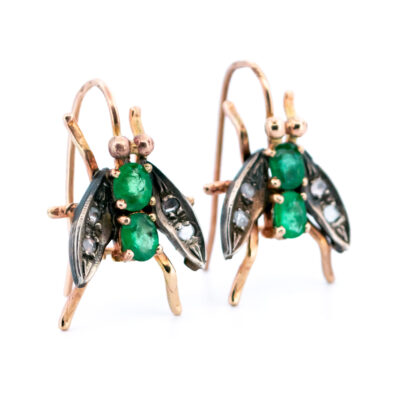This charming vintage Victorian-design insect brooch features approx. 0.80ct rose-cut diamonds accented with sapphires, emeralds and rubies, beautifully crafted in 14k and Silver.
Videos
Details: ±0.80ct Rose-cut diamonds, Sapphires, Emeralds, Rubies, 14k, Silver Brooch.
Design Era: Vintage Victorian.
Dimensions: 3.7 x 2 x 0.8 cm.
Weight in grams: 7,7.
Condition: Very good condition – slightly used with small signs of wear.
Shipping and Pickup: This charming piece ships from our store located in the center of Amsterdam, The Netherlands. We offer both registered shipping and local pickup at our store. In the case of local pickup, any applicable shipping costs will be refunded.
About Us: Add some sparkle to your style with Binenbaum.com. We offer a stunning selection of antique and vintage jewelry that you won’t find anywhere else. From timeless rings and dazzling necklaces to unique brooches, we have something for every taste and occasion. Visit our website today and treat yourself to a piece of history.
| Design Era | |
|---|---|
| Design & Historical Context | The Victorian Era was a time of great cultural and artistic flourishing in England, and this was reflected in the jewelry of the time. During the Victorian Era, a middle class began to emerge, which sparked a demand for jewelry in the mass market. Jewelry trends during this time often reflected the tone of current events. The Victorian Era is usually divided into three subsections: the Romantic Period (1837-1861), the Grand Period (1861-1880), and the Aesthetic Period (1880-1901). During the Romantic Period, jewelry featured nature-inspired designs similar to those of the Georgian era, and was characterized by its intricate and delicate detailing. Lockets and brooches were popular for daytime wear, while colored gemstones and diamonds were worn in the evening. During the Grand Period, known as the Mid-Victorian era, jewelry was often influenced by the death of Queen Victoria's husband. Many jewelry pieces from this period have solemn, somber designs and feature heavy, dark stones such as jet, onyx, amethyst, and garnet. This period also saw the emergence of highly creative, colorful designs using shells, mosaics, and gemstones. During the Aesthetic Period, jewelers used diamonds and feminine, bright gemstones such as sapphire, peridot, and spinel. Star and crescent designs, as well as elaborate hat pins, were also popular. Some scholars believe that the Aesthetic Period began earlier, in 1875, and ended as early as 1890. |
| Key Materials | |
| Materials & Craftsmanship | Rose-cut diamond: The Vintage Gem of Romance and Light Rose-cut diamonds are a beautiful and romantic choice in the world of jewelry, known for their distinctive dome-shaped appearance and soft, glowing sparkle. This antique diamond cut, dating back to the 16th century, features a flat bottom and a domed top covered in triangular facets that resemble the petals of a rosebud—hence the name. Historically, rose-cut diamonds were highly prized during the Georgian and Victorian eras, often used in jewelry pieces meant to be worn in candlelight, where their gentle sparkle added a warm, intimate glow. Unlike modern brilliant cuts, which are designed for maximum fire and brilliance, rose-cut diamonds offer a more subdued, yet enchanting, reflection of light. In modern jewelry, rose-cut diamonds are cherished for their vintage appeal and unique charm. Their flat base and shallow profile make them perfect for creating low-profile, elegant designs that sit close to the skin, such as in rings, pendants, and earrings. Rose-cut diamonds are often used in vintage-inspired and bespoke pieces, where their historical elegance adds a touch of timeless romance. Rose-cut diamonds are more than just a gemstone choice; they are a symbol of understated beauty and classic romance. Their soft, luminous sparkle and antique allure make them an ideal choice for jewelry that tells a story and captures the essence of a bygone era. Sapphire: The Gem of Wisdom and Royalty Sapphire, known for its stunning deep blue color, is a gemstone that embodies wisdom, loyalty, and nobility. This precious stone is a variety of the mineral corundum, and while blue is the most famous color, sapphires can also be found in a range of hues, including pink, yellow, green, and even colorless. Historically, sapphire has been revered across cultures for its association with the divine and the eternal. In ancient Persia, it was believed that the sky was painted blue by the reflection of sapphire stones. Throughout the ages, sapphire has been favored by royalty and clergy as a symbol of purity, virtue, and divine favor. Perhaps the most famous modern example is the sapphire engagement ring worn by Princess Diana and now by the Duchess of Cambridge. In jewelry, sapphire is celebrated for its beauty and durability, boasting a Mohs hardness of 9, second only to diamond. This makes sapphire an excellent choice for rings, necklaces, and earrings intended for everyday wear. The stone’s intense color and clarity are often highlighted by settings in white gold or platinum, though yellow gold can also enhance its warmth and depth. Sapphire is more than just a gemstone; it is a symbol of wisdom, fidelity, and nobility. Its rich history, combined with its remarkable durability and beauty, makes it a timeless and elegant choice for jewelry that signifies enduring love and commitment. Emerald: The Jewel of Renewal and Prosperity Emerald, with its vibrant green hue, is one of the most prized gemstones in the world, belonging to the beryl family. Its captivating color, ranging from deep forest green to bright spring green, is due to the presence of chromium and vanadium during its formation. Emeralds have been cherished throughout history, from ancient Egyptian pharaohs who believed the stone symbolized eternal youth, to Incan and Aztec civilizations that revered it as a holy stone. In the Renaissance period, emeralds were thought to possess the power to predict the future and reveal truth. In modern jewelry, emeralds are admired for their rich color and elegance. Although they are slightly softer than other precious stones, with a Mohs hardness of 7.5 to 8, their beauty and rarity make them a popular choice for rings, necklaces, and earrings. Emeralds often feature characteristic inclusions, known as jardin, which add to their uniqueness and charm. Emeralds symbolize renewal, growth, and prosperity, making them a timeless and meaningful choice for jewelry that exudes sophistication and natural beauty. Ruby: The Gem of Passion and Nobility Ruby, with its fiery red color, is one of the most coveted gemstones in the world, symbolizing passion, power, and nobility. This precious gem belongs to the corundum family, with its striking red hue derived from trace amounts of chromium. Rubies can range in color from deep crimson to vibrant red, often referred to as pigeon’s blood, the most prized shade. Throughout history, rubies have been revered as symbols of wealth and power. In ancient India, they were called the king of gemstones and were believed to protect warriors in battle. In medieval Europe, rubies were thought to bring good fortune, enhance love, and maintain health. Royals and aristocrats adorned themselves with rubies to signify their status and strength. In modern jewelry, rubies are celebrated for their durability and brilliance, with a Mohs hardness of 9, second only to diamonds. This makes them ideal for rings, necklaces, earrings, and other pieces designed for everyday wear. Rubies are often set in gold or platinum, where their vibrant color is showcased to its full potential, adding a touch of luxury and elegance to any design. Ruby is more than just a gemstone; it is a symbol of intense emotion, passion, and enduring strength. Its rich color and historical significance make it a timeless and powerful choice for jewelry that speaks of love, courage, and grandeur. 14k: The Durable Choice for Everyday Elegance 14k gold is a popular and practical choice in fine jewelry, known for its durability, affordability, and beautiful color. The 14k signifies that the gold is composed of 58.3% pure gold and 41.7% alloyed metals, such as copper, silver, nickel, or zinc. This combination results in a strong and resilient material that can withstand the rigors of daily wear, making it an ideal option for those seeking both beauty and durability. Historically, gold has always been a symbol of wealth and luxury, and 14k gold strikes a perfect balance between the rich appearance of gold and the strength needed for everyday use. Because of its lower gold content compared to 18k or 24k gold, 14k gold is more affordable, making it a popular choice for a wide range of jewelry pieces. In modern jewelry, 14k gold is appreciated for its versatility and variety. It is available in several colors, each achieved by mixing gold with different metals: Yellow Gold: A classic and timeless choice, 14k yellow gold has a warm, golden hue that complements most skin tones and is well-suited for both modern and traditional designs. White Gold: Created by alloying gold with white metals like nickel or palladium, 14k white gold has a sleek, silver-like appearance. It is often rhodium-plated for added shine and is a popular choice for engagement rings and other contemporary jewelry. Rose Gold: Achieved by mixing gold with copper, 14k rose gold has a soft, pinkish hue that has gained popularity for its romantic and vintage appeal. It is a favorite for those seeking a unique and stylish alternative to traditional gold colors. 14k gold is commonly used in a wide array of jewelry, including rings, necklaces, bracelets, earrings, and watches. Its durability makes it especially suitable for pieces that are worn daily, such as wedding bands and engagement rings, where the balance between strength and beauty is crucial. 14k gold is more than just a practical choice; it is a symbol of enduring style and everyday luxury. Its ability to retain the look of gold while offering greater resistance to scratches and dents makes 14k gold a versatile and timeless option for any jewelry collection. Whether in a simple band or an elaborate design, 14k gold offers a perfect blend of elegance and durability that can be enjoyed for years to come. Silver: The Metal of Elegance and Versatility Silver, known for its bright, reflective luster, is one of the most beloved and widely used precious metals in the world. This versatile metal has been cherished for thousands of years, not only for its beauty but also for its malleability, making it ideal for crafting intricate and delicate jewelry designs. Historically, silver has been associated with the moon and considered a symbol of purity, clarity, and protection. Ancient civilizations, from the Egyptians to the Greeks and Romans, valued silver for its beauty and used it to create coins, jewelry, and religious artifacts. In many cultures, silver is also believed to have healing properties, often used in amulets and talismans to ward off negative energy. In modern jewelry, silver is prized for its affordability, versatility, and timeless appeal. Sterling silver, an alloy of 92.5% pure silver and 7.5% other metals (usually copper), is the standard used in high-quality jewelry. Its durability and bright, reflective surface make it an excellent choice for a wide range of designs, from minimalist pieces to ornate creations. Silver can be polished to a high shine or given a matte, oxidized, or antiqued finish to suit various styles. Silver is more than just a metal; it is a symbol of elegance, flexibility, and understated luxury. Its enduring popularity and wide-ranging applications make it a staple in jewelry that can complement any look, from casual to formal, with timeless grace. |
| Dimensions | 3.7 x 2 x 0.8 cm |
| Gender | |
| Weight (in grams) | 7,7 |
| Condition | Very good condition – slightly used with small signs of wear |
By following these tips, you can enjoy your precious jewelry for many years to come.
Related Products
-
Diamond 14k Silver Victorian Brooch 14923-8423
€ 2.695,00 VAT incl. (where applicable) -
Diamond 18k Platinum Bar Brooch 16248-8772
€ 2.995,00 VAT incl. (where applicable) -
Marcasite (Pyrite) Onyx Ruby Silver Mouse Brooch 16227-2515
€ 195,00 VAT incl. (where applicable) -
Diamond Deco Brooch 14950-2444
€ 2.895,00 VAT incl. (where applicable) -
Diamond Pearl 14k Platinum Deco Brooch 14922-8422
€ 1.395,00 VAT incl. (where applicable) -
Sapphire 14k Floral Brooch 14934-8433
€ 995,00 VAT incl. (where applicable) -
Diamond Sapphire 9k Silver Insect Earrings 14370-8318
€ 1.895,00 VAT incl. (where applicable) -
Diamond Emerald 9k Insect Earrings 13550-8179
€ 1.895,00 VAT incl. (where applicable)
- Home
- Collection
- Fine Jewelry
- Silver Jewelry
- Silverware
- Boxes
- Candlesticks
- Salt and pepper shakers
- Miniatures
- Salt cellars
- Spoon Set
- Condiments
- Frames
- Napkin Ring
- Spoon
- Oddities
- Cups
- Vases
- Cutlery
- Serving Spoon And Cake Server
- Candlesticks
- Baskets
- Hanukkiah
- Spice Tower
- Yad
- Tea Set
- Sugar Castor
- Napkin Rings
- Wine Bottle Coaster
- Wine Stopper
- Tea Pot
- Jugs
- Rattles
- Hip Flask
- Miscellaneous
- Rings 💍
- About
- Contact







